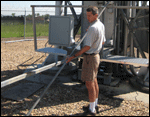Two NOAA "Teachers in the Lab" at PSL
July 13, 2009
 Peter Blanken at the Boulder Atmospheric Observatory. Photo credit: Dan Wolfe |
Two teachers are spending three weeks this summer working at the ESRL's Physical Sciencdes Division (PSL) as part of NOAA's "Teacher in the Lab" pilot program. The Teacher in the Lab program is an expansion of NOAA's Teacher at Sea program with the purpose to provide teachers hands-on experience in a NOAA lab working side-by-side with NOAA scientists on a research project. Drs. Peter Blanken (Associate Professor at the University of Colorado) and Diane Stanitski (who will teach at the United States Naval Academy) have specific interests in air-sea fluxes and boundary layer climatology, which align perfectly with the expertise of their PSL mentors, Dr. Chris Fairall and Daniel Wolfe. They are working closely together to identify ways to improve education and outreach associated with these scientific topics. For the field experience portion of the program, Blanken will work with instruments on the 300-meter tall Boulder Atmospheric Observatory tower to monitor atmospheric profiles of temperature, moisture, wind and carbon. Stanitski will conduct an intercomparison test between flux sensors on the University of Hawaii R/V Kilo Moana, and the WHOTS ocean reference mooring north of the island of Oahu.
The goals of the NOAA Teacher in the Lab program are to increase knowledge among teachers of earth system science, in line with Ocean and Climate Literacy Principles, and increase teachers' knowledge of careers that support earth system science. Four NOAA labs are hosting a total of five teachers this summer in this project: Earth System Research Laboratory, Boulder; Alaska Fisheries Science Center, Juneau; South West Fisheries Science Center, La Jolla; and South East Fisheries Science Center, Miami.
This collaboration will extend well beyond the three weeks working together in the laboratory and field. Future plans include co-authoring papers and reports, co-presenting talks at professional meetings, and team teaching in courses during the 2009-2010 school year. Lesson plans for undergraduates will be designed using NOAA data, and a children's book describing Careers in the Atmospheric Sciences will be created. An additional goal is to have more students from the University of Colorado–Boulder and other academic institutions become more directly involved in research at ESRL since a vast array of collaborative potential exists. Improved outreach and education resources support NOAA's mission goal to help society understand, plan for, and respond to climate variability and change.
| Contact: Chris Fairall and Dan Wolfe |